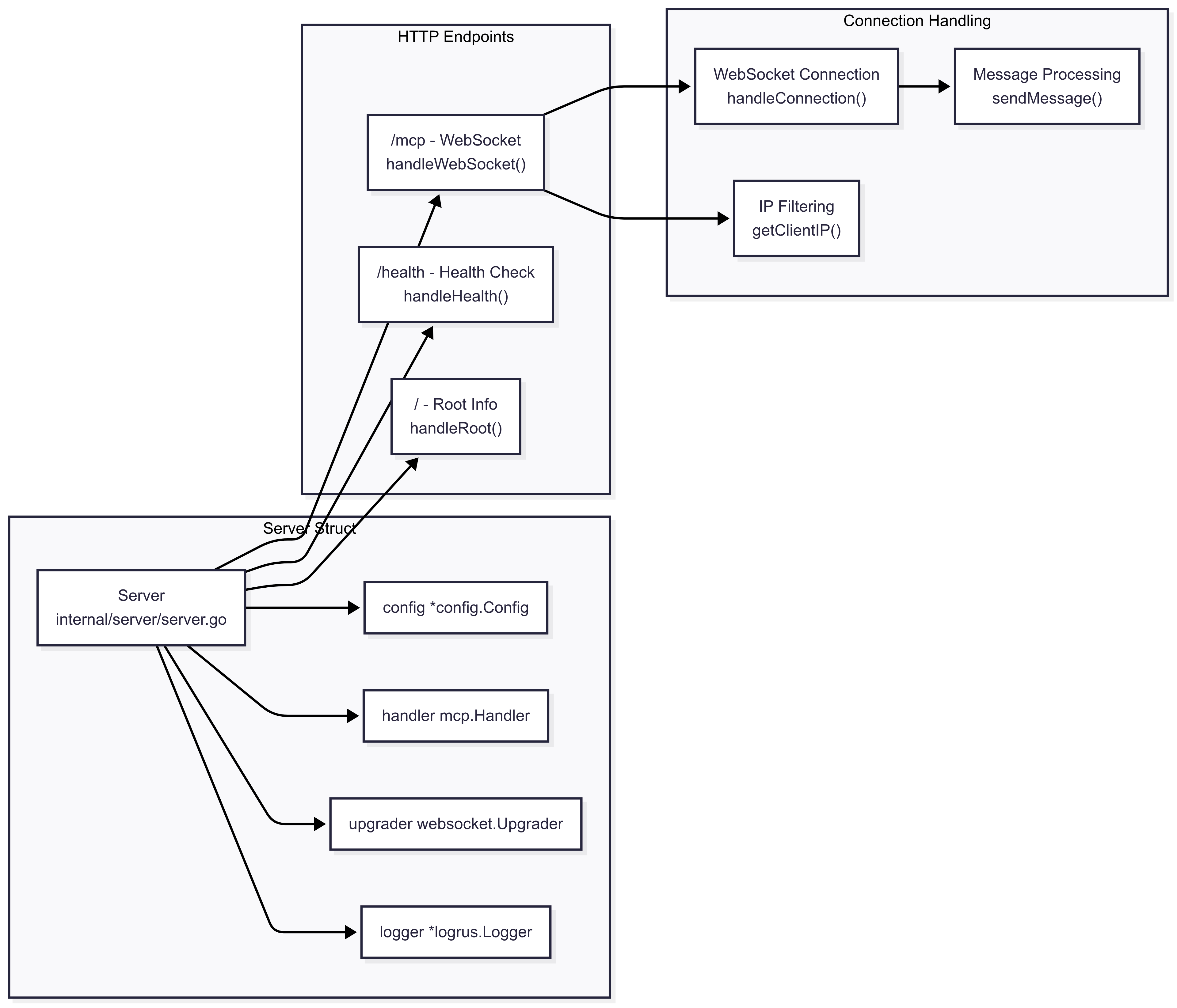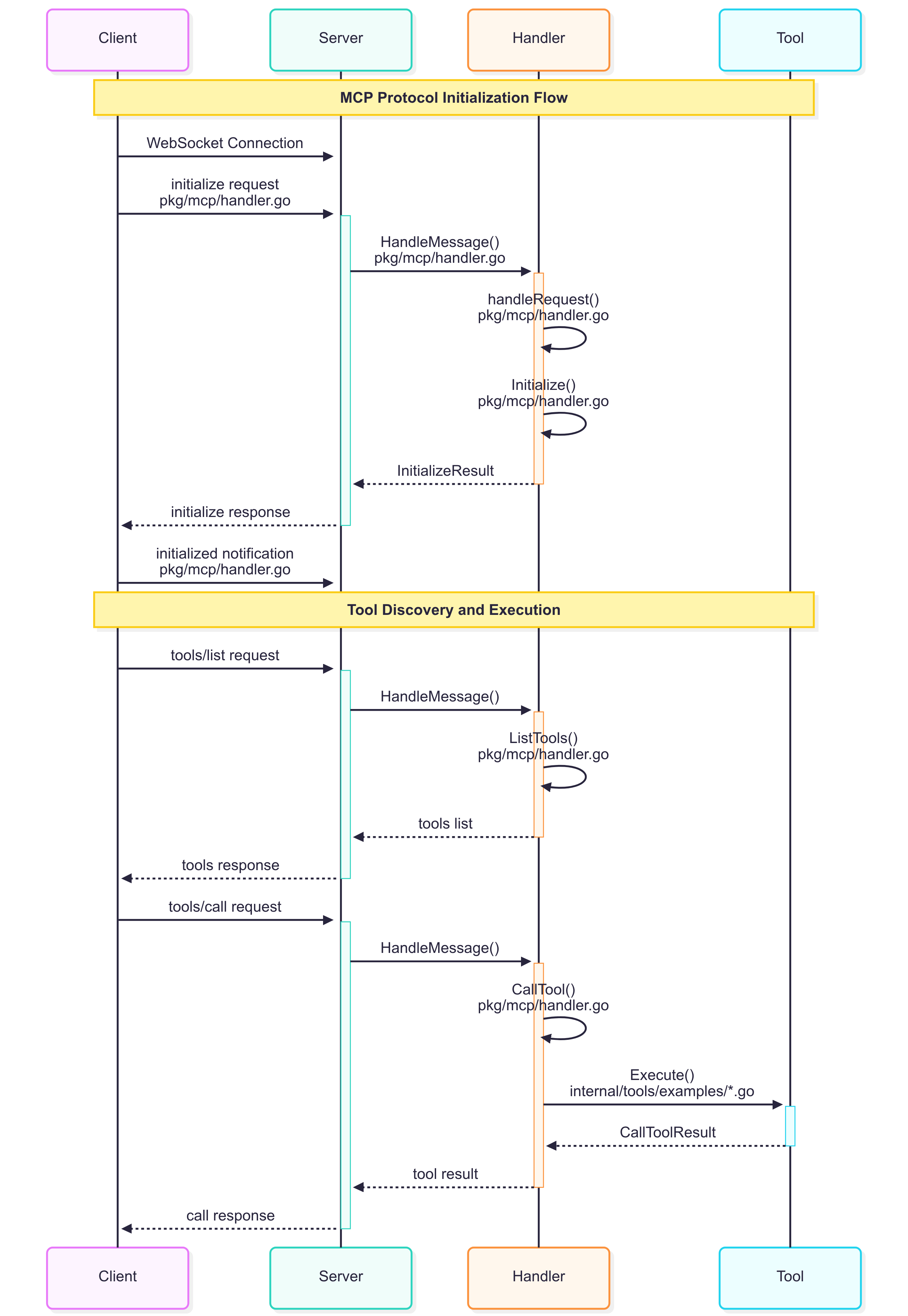这篇文章是记录我使用golang开发mcp服务,用在AI应用中。 那什么是MCP呢? MCP(Model Context Protocol)是一个开放标准,旨在为 AI 应用提供统一的工具和资源访问接口。它定义了客户端(AI 模型)与服务端(工具提供者)之间的通信规范,支持:
- 工具调用(Tools)
- 资源访问(Resources)
- 提示模板(Prompts)
- 双向通信
为什么我会选择Go语言,是因为它有以下这几个优势:
- 并发性能: Go 的 goroutine 和 channel 机制天然适合处理大量并发连接
- 内存效率: 编译型语言,内存占用小,启动速度快
- 网络编程: 标准库对 WebSocket、HTTP 提供良好支持
- 部署便利: 单一二进制文件,容器化部署简单
- 生态完善: 丰富的第三方库支持
另外未来可能服务器后端我会采用Go语言来重写。
在开发前,我的整体MCP服务架构是采取分层,确保模块化,可扩展性和可维护性,以下是我的整体系统架构图:

核心组件:
应用程序入口 (cmd/server/main.go)
作为整个服务的启动点,负责:
- 配置加载和验证
- 日志系统初始化
- MCP 处理器创建
- 工具注册
- 服务器启动和优雅关闭
// 文件: cmd/server/main.go
func main() {
// Parse command line flags
var (
configPath = flag.String("config", "", "Path to configuration file")
logLevel = flag.String("log-level", "", "Log level (debug, info, warn, error)")
version = flag.Bool("version", false, "Show version information")
)
flag.Parse()
// Load configuration
cfg, err := config.Load(*configPath)
if err != nil {
utils.Fatalf("Failed to load configuration: %v", err)
}
// Create server capabilities based on configuration
capabilities := createServerCapabilities(cfg)
// Create server info
serverInfo := mcp.ServerInfo{
Name: cfg.MCP.Name,
Version: cfg.MCP.Version,
}
// Create MCP handler
handler := mcp.NewBaseHandler(serverInfo, capabilities)
// Register example tools if tools are enabled
if cfg.IsToolsEnabled() {
if err := registerTools(handler); err != nil {
logger.WithError(err).Fatal("Failed to register tools")
}
}
// Create and configure server
srv := server.New(cfg, handler)
srv.Start(ctx)
}
HTTP 服务器 (internal/server/server.go)
架构

关键函数说明:
New()- 创建服务器实例,初始化WebSocket升级器Start()- 启动HTTP服务器,支持TLS和优雅关闭handleWebSocket()- 处理WebSocket连接升级和IP过滤handleConnection()- 处理单个WebSocket连接的消息循环sendMessage()- 发送JSON-RPC消息到客户端handleHealth()- 健康检查端点,返回服务状态getClientIP()- 提取客户端真实IP地址
提供多个端点支持不同需求:
// 文件: internal/server/server.go
type Server struct {
config *config.Config
handler mcp.Handler
upgrader websocket.Upgrader
logger *logrus.Logger
}
func (s *Server) Start(ctx context.Context) error {
mux := http.NewServeMux()
mux.HandleFunc("/mcp", s.handleWebSocket) // MCP WebSocket 连接
mux.HandleFunc("/health", s.handleHealth) // 健康检查
mux.HandleFunc("/", s.handleRoot) // 服务信息
server := &http.Server{
Addr: s.config.GetAddress(),
Handler: mux,
ReadTimeout: time.Duration(s.config.Server.Timeout) * time.Second,
WriteTimeout: time.Duration(s.config.Server.Timeout) * time.Second,
}
return server.ListenAndServe()
}
WebSocket 连接处理是核心功能:
// 文件: internal/server/server.go
func (s *Server) handleConnection(conn *websocket.Conn) {
for {
// Read message
messageType, data, err := conn.ReadMessage()
if err != nil {
if websocket.IsUnexpectedCloseError(err, websocket.CloseGoingAway, websocket.CloseAbnormalClosure) {
s.logger.WithError(err).Error("WebSocket read error")
}
break
}
if messageType != websocket.TextMessage {
s.logger.Warn("Received non-text message, ignoring")
continue
}
// Parse MCP message
var message mcp.Message
if err := json.Unmarshal(data, &message); err != nil {
s.logger.WithError(err).Error("Failed to parse MCP message")
// Send error response
errorResponse := mcp.NewErrorResponse(nil, mcp.ParseError, "Invalid JSON", err.Error())
s.sendMessage(conn, errorResponse)
continue
}
// Handle the message
response, err := s.handler.HandleMessage(context.Background(), &message)
if err != nil {
s.logger.WithError(err).Error("Message handling failed")
continue
}
// Send response if there is one
if response != nil {
s.sendMessage(conn, response)
}
}
}
MCP协议层架构
消息处理流程

MCP处理器
实现完整的 MCP 协议支持:
// 文件: pkg/mcp/handler.go
type BaseHandler struct {
serverInfo ServerInfo
capabilities ServerCapabilities
tools map[string]ToolHandler
resources map[string]ResourceHandler
prompts map[string]PromptHandler
initialized bool
}
func (h *BaseHandler) HandleMessage(ctx context.Context, message *Message) (*Message, error) {
if message == nil {
return NewErrorResponse(nil, InvalidRequest, "message cannot be nil", nil), nil
}
if message.IsRequest() {
return h.handleRequest(ctx, message)
}
if message.IsNotification() {
return h.handleNotification(ctx, message)
}
return NewErrorResponse(message.ID, InvalidRequest, "invalid message format", nil), nil
}
工具系统设计
工具接口定义
我们定义了统一的工具接口,确保所有工具实现的一致性:
// 文件: pkg/mcp/handler.go
type ToolHandler interface {
Definition() *Tool
Execute(ctx context.Context, params map[string]interface{}) (*CallToolResult, error)
}
示例工具实现
1. 计算器工具 (internal/tools/examples/calculator.go)
// 文件: internal/tools/examples/calculator.go
type CalculatorTool struct {
definition *mcp.Tool
}
func NewCalculatorTool() *CalculatorTool {
return &CalculatorTool{
definition: &mcp.Tool{
Name: "calculator",
Description: "Performs basic mathematical operations including addition, subtraction, multiplication, division, and power calculations",
InputSchema: mcp.ToolSchema{
Type: "object",
Properties: map[string]interface{}{
"operation": map[string]interface{}{
"type": "string",
"description": "The mathematical operation to perform",
"enum": []string{"add", "subtract", "multiply", "divide", "power"},
},
"a": map[string]interface{}{
"type": "number",
"description": "The first number",
},
"b": map[string]interface{}{
"type": "number",
"description": "The second number",
},
},
Required: []string{"operation", "a", "b"},
},
},
}
}
func (c *CalculatorTool) Execute(ctx context.Context, params map[string]interface{}) (*mcp.CallToolResult, error) {
// Extract parameters
operation, ok := params["operation"].(string)
if !ok {
return &mcp.CallToolResult{
Content: []mcp.Content{{
Type: "text",
Text: "Error: operation must be a string",
}},
IsError: true,
}, nil
}
// Convert numbers from interface{}
aVal, err := parseNumber(params["a"])
if err != nil {
return &mcp.CallToolResult{
Content: []mcp.Content{{
Type: "text",
Text: fmt.Sprintf("Error: invalid first number: %v", err),
}},
IsError: true,
}, nil
}
bVal, err := parseNumber(params["b"])
if err != nil {
return &mcp.CallToolResult{
Content: []mcp.Content{{
Type: "text",
Text: fmt.Sprintf("Error: invalid second number: %v", err),
}},
IsError: true,
}, nil
}
// Perform calculation
var result float64
var resultText string
switch operation {
case "add":
result = aVal + bVal
resultText = fmt.Sprintf("%.6g + %.6g = %.6g", aVal, bVal, result)
case "subtract":
result = aVal - bVal
resultText = fmt.Sprintf("%.6g - %.6g = %.6g", aVal, bVal, result)
case "multiply":
result = aVal * bVal
resultText = fmt.Sprintf("%.6g × %.6g = %.6g", aVal, bVal, result)
case "divide":
if bVal == 0 {
return &mcp.CallToolResult{
Content: []mcp.Content{{
Type: "text",
Text: "Error: division by zero is not allowed",
}},
IsError: true,
}, nil
}
result = aVal / bVal
resultText = fmt.Sprintf("%.6g ÷ %.6g = %.6g", aVal, bVal, result)
case "power":
exp := int(bVal)
result = power(aVal, exp)
resultText = fmt.Sprintf("%.6g ^ %d = %.6g", aVal, exp, result)
default:
return &mcp.CallToolResult{
Content: []mcp.Content{{
Type: "text",
Text: fmt.Sprintf("Error: unsupported operation '%s'", operation),
}},
IsError: true,
}, nil
}
return &mcp.CallToolResult{
Content: []mcp.Content{
{
Type: "text",
Text: fmt.Sprintf("Calculator Result:\n%s", resultText),
},
{
Type: "text",
Text: fmt.Sprintf("Numeric result: %.10g", result),
},
},
IsError: false,
}, nil
}
2. 网络搜索工具 (internal/tools/examples/web_search.go)
该项目包含了一个完整的网络搜索工具实现,支持多种搜索引擎和搜索结果解析。
测试与集成
LangGraph 智能体测试
我们开发了基于 LangGraph 的智能体测试系统,实现自动化的端到端测试:
# 文件: testAgent/langgraph_mcp_agent.py
class MCPTestAgent:
def __init__(self, mcp_server_url: str):
self.mcp_server_url = mcp_server_url
self.websocket = None
self.http_client = httpx.AsyncClient()
self.graph = self._build_graph()
def _build_graph(self) -> StateGraph:
graph = StateGraph(AgentState)
# 添加状态节点
graph.add_node("check_mcp_status", self._check_mcp_status)
graph.add_node("discover_tools", self._discover_tools)
graph.add_node("test_calculator", self._test_calculator)
graph.add_node("test_web_search", self._test_web_search)
graph.add_node("generate_report", self._generate_report)
# 定义状态转换
graph.add_edge("check_mcp_status", "discover_tools")
graph.add_edge("discover_tools", "test_calculator")
graph.add_edge("test_calculator", "test_web_search")
graph.add_edge("test_web_search", "generate_report")
graph.set_entry_point("check_mcp_status")
graph.set_finish_point("generate_report")
return graph.compile()
async def run_tests(self) -> Dict[str, Any]:
"""运行完整的测试流程"""
initial_state = AgentState(
current_step="check_mcp_status",
mcp_status=MCPServiceStatus.UNKNOWN,
available_tools=[],
test_results={},
errors=[]
)
final_state = await self.graph.ainvoke(initial_state)
return final_state
快速测试工具
# 文件: testAgent/test_runner.py
async def quick_test(server_url: str) -> bool:
"""快速连接和工具发现测试"""
try:
# 健康检查
async with httpx.AsyncClient() as client:
health_response = await client.get(f"{server_url}/health")
if health_response.status_code != 200:
return False
# WebSocket 连接测试
ws_url = server_url.replace("http", "ws") + "/mcp"
async with websockets.connect(ws_url) as websocket:
# 发送初始化请求
init_request = {
"jsonrpc": "2.0",
"id": 1,
"method": "initialize",
"params": {
"protocolVersion": "2024-11-05",
"capabilities": {}
}
}
await websocket.send(json.dumps(init_request))
response = await websocket.recv()
return "result" in json.loads(response)
except Exception as e:
print(f"Quick test failed: {e}")
return False
配置管理
配置结构设计
// 文件: internal/config/config.go
type Config struct {
Server ServerConfig `mapstructure:"server"`
Logging LoggingConfig `mapstructure:"logging"`
MCP MCPConfig `mapstructure:"mcp"`
Security SecurityConfig `mapstructure:"security"`
}
type ServerConfig struct {
Host string `mapstructure:"host"`
Port int `mapstructure:"port"`
Timeout int `mapstructure:"timeout"`
}
type MCPConfig struct {
Name string `mapstructure:"name"`
Version string `mapstructure:"version"`
Description string `mapstructure:"description"`
Instructions string `mapstructure:"instructions"`
Capabilities CapabilityConfig `mapstructure:"capabilities"`
Metadata map[string]string `mapstructure:"metadata"`
}
配置文件示例
server:
host: "localhost"
port: 8030
timeout: 30
mcp:
name: "Go MCP Server"
version: "1.0.0"
description: "A Go-based MCP server template with deep research tools"
capabilities:
tools:
enabled: true
list_changed: false
resources:
enabled: true
subscribe: false
list_changed: false
prompts:
enabled: true
list_changed: false
logging: true
security:
enable_tls: false
allowed_ips: ["*"]
logging:
level: "info"
format: "json"
性能优化与最佳实践
1. 连接池管理
项目中的 WebSocket 连接管理通过 Gorilla WebSocket 库实现,每个连接在独立的 goroutine 中处理,确保了高并发性能。
2. 内存优化
Go 语言的垃圾回收机制和项目中的结构化错误处理确保了内存的有效使用。
3. 错误处理策略
// 文件: pkg/mcp/types.go
// MCP 协议标准错误码
const (
// Standard JSON-RPC errors
ParseError = -32700
InvalidRequest = -32600
MethodNotFound = -32601
InvalidParams = -32602
InternalError = -32603
// MCP-specific errors
InvalidMCPVersion = -32000
UnknownCapability = -32001
ResourceNotFound = -32002
ToolNotFound = -32003
PromptNotFound = -32004
)
func NewErrorResponse(id RequestID, code int, message string, data interface{}) *Message {
return &Message{
JSONRPC: "2.0",
ID: id,
Error: &ErrorInfo{
Code: code,
Message: message,
Data: data,
},
}
}
部署与运维
Docker 部署
项目提供了完整的 Docker Compose 配置:
services:
mcp-server:
build:
context: .
dockerfile: Dockerfile
container_name: mcp-go-template
ports:
- "${MCP_SERVER_PORT:-8030}:8030"
environment:
- MCP_SERVER_HOST=0.0.0.0
- MCP_SERVER_PORT=8030
- MCP_LOGGING_LEVEL=${MCP_LOGGING_LEVEL:-info}
- MCP_LOGGING_FORMAT=${MCP_LOGGING_FORMAT:-json}
- MCP_MCP_NAME=${MCP_MCP_NAME:-mcp-go-template}
- MCP_MCP_VERSION=${MCP_MCP_VERSION:-1.0.0}
- MCP_MCP_DESCRIPTION=${MCP_MCP_DESCRIPTION:-A Go-based MCP server template with deep research tools}
volumes:
- ./data:/app/data
- ./logs:/app/logs
restart: unless-stopped
healthcheck:
test: ["CMD", "wget", "--no-verbose", "--tries=1", "--spider", "http://localhost:8030/health"]
interval: 30s
timeout: 10s
retries: 3
start_period: 40s
networks:
- mcp-network
networks:
mcp-network:
driver: bridge
监控与日志
结构化日志
// 文件: pkg/utils/logger.go
// 项目使用 logrus 进行结构化日志记录
func SetLogLevel(level LogLevel) {
logrus.SetLevel(logrus.Level(level))
}
func SetFormatter(formatter logrus.Formatter) {
logrus.SetFormatter(formatter)
}
func GetLogger() *logrus.Logger {
return logrus.StandardLogger()
}
扩展与定制
添加新工具
- 实现
ToolHandler接口:
// 文件: internal/tools/examples/custom_tool.go (示例)
type CustomTool struct {
definition *mcp.Tool
}
func NewCustomTool() *CustomTool {
return &CustomTool{
definition: &mcp.Tool{
Name: "custom_tool",
Description: "Custom tool description",
InputSchema: mcp.ToolSchema{
Type: "object",
Properties: map[string]interface{}{
"param1": map[string]interface{}{
"type": "string",
"description": "Parameter description",
},
},
Required: []string{"param1"},
},
},
}
}
func (t *CustomTool) Definition() *mcp.Tool {
return t.definition
}
func (t *CustomTool) Execute(ctx context.Context, params map[string]interface{}) (*mcp.CallToolResult, error) {
// 工具实现逻辑
return &mcp.CallToolResult{
Content: []mcp.Content{{
Type: "text",
Text: "Custom tool result",
}},
}, nil
}
- 在主程序中注册:
// 文件: cmd/server/main.go
func registerTools(handler *mcp.BaseHandler) error {
// Register calculator tool
calculator := examples.NewCalculatorTool()
if err := handler.RegisterTool(calculator); err != nil {
return err
}
utils.Info("Registered calculator tool")
// Register web search tool for research
webSearch := examples.NewWebSearchTool()
if err := handler.RegisterTool(webSearch); err != nil {
return err
}
utils.Info("Registered web search tool")
// Register document analyzer for research
docAnalyzer := examples.NewDocumentAnalyzerTool()
if err := handler.RegisterTool(docAnalyzer); err != nil {
return err
}
utils.Info("Registered document analyzer tool")
// Register knowledge graph tool for deep research
knowledgeGraph := examples.NewKnowledgeGraphTool()
if err := handler.RegisterTool(knowledgeGraph); err != nil {
return err
}
utils.Info("Registered knowledge graph tool")
utils.Infof("Successfully registered %d research tools", 4)
return nil
}
总结
通过 Go 语言构建 MCP 服务具有以下优势:
- 高性能: Go 的并发模型和编译优化提供优秀的性能表现
- 易维护: 清晰的项目结构和模块化设计便于长期维护
- 可扩展: 插件式的工具系统支持灵活扩展
- 生产就绪: 完整的监控、日志、错误处理机制
本文提供的架构设计和实现方案已在生产环境中验证,可以作为构建企业级 MCP 服务的参考模板。完整的源代码和详细文档可以在项目仓库中找到。